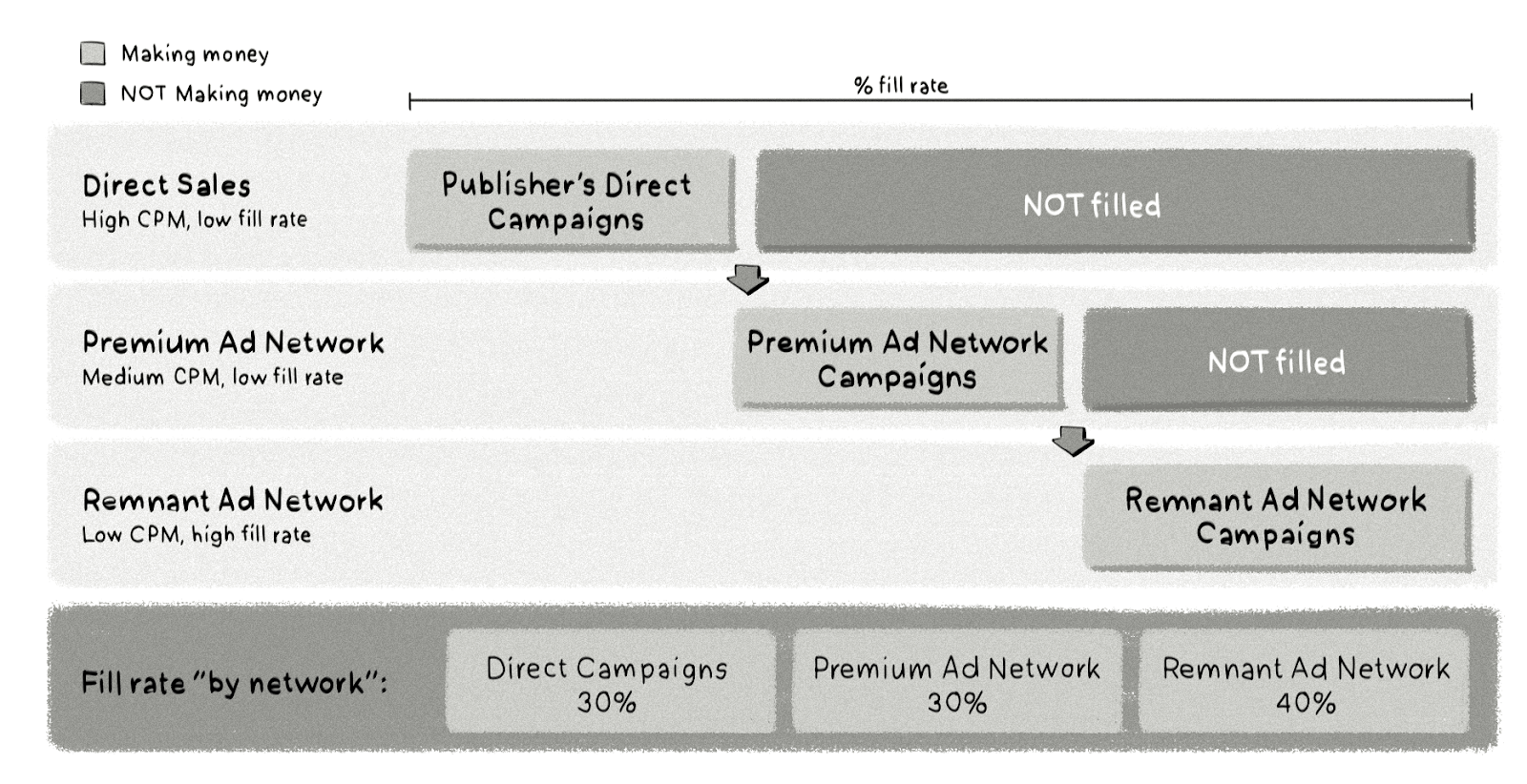Ad networks were one of the first pieces of advertising technology (AdTech) to be introduced to the online advertising industry back in the late 1990s. Despite the various technological advances and new media-buying processes, such as real-time bidding (RTB), ad networks still remain a key element of programmatic advertising.
In this article, we’ll explain what an ad network is, how it works, what the key features of an ad network are, and showcase a development project where we designed and built an ad network for an advertising agency.
Key Points
- An ad network is a technology platform that operates as a middleman to allow a group of advertisers and publishers to buy and sell digital advertising.
- An ad network gathers all available inventory from a publisher and offers it to advertise as a bundle of impressions.
- Building a custom ad network will benefit companies that have access to both supply and demand.
- Renting an existing ad network allows you to start using it immediately and has lower upfront costs. However, you won’t have ownership or control over the data, product roadmap or features.
- Building an ad network allows you to own the intellectual property (IP), build the features you really need, and help keep your and your clients’ data secure.
- An advertising agency partnered with Clearcode to improve the performance of its ad network and expand the feature set.
What Is an Ad Network?
An ad network is a technology platform that operates as a middleman to allow a group of advertisers and publishers to buy and sell digital advertising. Ad networks appeared in the mid 90’s and were one of the pioneers of advertising technology. The purpose of ad networks has been the same since the beginning — to help advertisers purchase available ad space across various publishers.
The main goal of an ad network is to collect unsold inventory (non-premium or remnant) from multiple publishers and offer it to advertisers at a much lower price than the publisher’s initial offer.
But ad networks aren’t only for selling remnant inventory — some ad networks offer advertisers more exclusive deals at premium prices. They select and purchase inventory beforehand from some leading publishers and then sell it at higher prices.This may cost advertisers more, but it guarantees them prime and secure placements for their ads.
We Can Help You Build an Ad Network
Our AdTech development teams can work with you to design, build, and maintain a custom-built demand-side platform (DSP) for any programmatic advertising channel.
How Does an Ad Network Work?
An ad network gathers all available inventory from a publisher and offers it to advertise as a bundle of impressions.
Here’s a step-by-step explanation of how an ad network works:
- An ad network partners with a vast number of publishers to provide advertisers with large amounts of inventory.
- Advertisers create campaigns using the ad network’s campaign management system. They can also add pixels from a third-party ad server for verification purposes and to consolidate reporting for campaigns run across multiple ad networks.
- Advertisers set up the campaign’s settings, including targeting, budget, and frequency limits. The publisher places the ad network’s tags on their website either by directly inserting the tags into the page or utilizing a first-party ad server.
- After displaying an ad, the advertisers can control and rotate multiple banners using the ad network’s campaign management system without the need to contact a publisher.
During the early stages of online advertising when the number of websites and advertisers was limited, publishers mostly relied on a single ad network to sell their unsold inventory.
However, as the number of publisher sites expanded, they realized that they could not sell all their inventory through a single ad network and were faced with low fill rates.
In order to improve their fill rates, publishers started utilizing multiple ad networks, with some providing premium inventory and others offering remnant inventory.

Many ad networks specialize in certain types of inventory, including
- Premium ad networks: Offer inventory from the top publisher brands (e.g. The New York Times).
- Vertical ad networks: Focus on certain topics, such as business, technology, automotive, fashion, etc.
- Specialized ad networks: Focus on a certain type of channel (e.g. mobile, video, native).
- Performance and affiliate ad networks: Use the revenue share, cost-per-click (CPC), or cost-per-action (CPA) pricing model.
The targeting and decision-making processes in ad networks work in a similar way to those found in ad servers, but there are a few slight differences. By setting targeting criteria for a campaign, an advertiser can choose which web traffic is relevant for them.
Who Can Benefit From Building an Ad Network?
Building a custom ad network will benefit companies that have access to both supply and demand. For example, an advertising agency that has many brands and their clients and partnerships with multiple publishers can benefit from building their own ad network as it will allow them to avoid using third-party ad networks, meaning they can save money on commissions and fees as well as have more control over the features and product roadmap.
Also, existing AdTech vendors can expand their client offering by building an ad network.
In addition, publishers and media companies can build an ad network to facilitate the ad buying and selling process across their properties, e.g. websites, apps and streaming services.
Key Features of an Ad Network
Traffic and audience detection and campaign matching: Identifying the traffic source and audiences and matching them with relevant ad campaigns.
Advanced reporting: Displaying various metrics relating to the performance of the ad campaigns and audiences.
Header bidding adapter: Providing publishers with a header bidding (e.g. Prebid) adapter to access more demand.
Varied ad formats: Offering advertisers different ad formats, e.g. display, native and video ads.
User interface: Providing both publishers and advertisers with an easy-to-use user interface (UI) that allows them to create ad campaigns, create and manage user accounts, and view reports.
The Main Challenges You’ll Face When Building an Ad Network
When building an ad network, a company should consider the following challenges and specify their requirements to get a platform that meets their business needs:
- The scale of inventory: Refers to the amount of traffic that the ad network can manage, as any increase in traffic may impact the stability and performance of the ad network.
- Infrastructure setup: Needs to be able to handle the process of buying and selling inventory and reporting on campaign performance.
- Key features: The ad network should include the main features found in most ad networks, e.g., traffic detection and reporting systems, as well as ones that are specific to the clients it represents.
Should You Build or Rent an Ad Network?
What Does It Mean to Rent an Ad Network?
Renting an AdTech or MarTech platform involves signing a contract with a vendor and paying a recurring fee to use the platform, typically on a monthly basis. This is the most preferred method as it enables businesses to immediately start utilizing the platform without the need to build it from scratch.
However, there are many benefits of building an ad network, and for some companies, it’s the only option.
The Advantages of Renting an Ad Network
- Immediate start: In most cases, you can start using the ad network within hours of creating an account.
- Lower initial costs: Many AdTech platforms take a percentage of the media spend as their fee, eliminating the need for any upfront costs. However, some white-label solutions or larger AdTech vendors may impose a monthly fee in addition to media spend.
The Disadvantages of Renting an Ad Network
- No control over the features and product roadmap: When renting an ad network, you have little or no control over current or future features, which means you can’t build new features that your clients are requesting or that will improve your business.
- No ownership of the tech or data: For most businesses, such as agencies and brands, owning the technology and data is not necessary. However, AdTech and MarTech companies often have no choice but to own the tech and data. Publishers, media companies, telecommunications companies, and medium to large-sized agencies can also benefit from owning the data technology as it provides them with complete control over its integration with other systems, can increase the value of their company, and stops their data being used by other companies.
- Fees and commissions: The decision to build your own ad network depends on a number of factors, such as the type of business you operate, your media spending or ad revenue, and your long-term financial goals. Although there is a cost involved in building and maintaining the platform, it can lead to cost savings over time, particularly for companies that have a high media spend or earn substantial ad revenue.
What Does It Mean to Build An Ad Network?
Building a custom ad network means undertaking a software development project where you design and build the platform and features, set up the integrations, and design the UX/UI (i.e. the user interface).
The time it takes to design, build and launch an ad network platform depends on a number of factors, such as the budget and timeframes, feature set, and technical complexities.
Some development projects may last from 4 to 6 months, while more complex ones can last 18 months or more.
Essentially, the more developers working on the project, the less amount of time it will take to build the minimum viable product (MVP).
The Advantages of Building an Ad Network
- Data ownership: Having ownership over the data can make it easier for you and your clients to comply with data protection and privacy regulations, such as the General Data Protection Regulation (GDPR). Additionally, it allows you to use first-party data for ad targeting, measurement and reporting and eliminates the possibility of your competitors utilizing your data.
- Control of intellectual property (IP): Owning the intellectual property, including the code and algorithms, can increase the value of your company.
- Control over the product roadmap and features: By being able to build the features you want, you can develop unique features that set you apart from competitors and allow you to increase your business. This not only means that you’ll get the features you need, but also the platform will be built to align with your business objectives, strategy, and vision.
- Reduction of fees and commissions: Charging a markup ranging from 10% to 30% is quite common for many AdTech providers, which can result in significant expenses if you spend a lot on media. You can decrease these costs by building your own ad network, which can potentially save you millions of dollars annually.
The Disadvantages of Building an Ad Network
- Large financial investment: Building your own ad network requires a big initial investment, especially at the beginning, compared to renting a platform.
- Time commitment: Developing and launching the first working version (i.e. the MVP) may take up to 6 months, but the development time depends on the technical requirements and features you’d like to have.
- Technical maintenance: Monitoring and providing technical support to the newly built ad network is something companies that build their own ad networks should keep in mind.
Case Study: An Ad Network for an Advertising Agency
One of the ad networks that Clearcode designed and built was for an advertising agency. Our client’s existing ad network lacked a few essential features, such as traffic detection and advanced reporting, and experienced issues with the performance of the ad network.
The main goals of the development project were to:
- Optimize the ad network by building new key features related to traffic detection and advanced reporting.
- Improve performance by refactoring the existing codebase and adding new code to ensure backward compatibility.
- Increase the number of ad requests from 2 million daily ad requests to about 3 million daily ad requests.
- Create a stable infrastructure environment for the ad network.
1. Refactor the Codebase
We improved the performance of the ad network by introducing new code and refactoring the existing code base, as it was the only solution to improve the performance of an existing ad network. At the same time, we ensured backward compatibility, allowing the existing processes to perform correctly.
2. Build and Extend Key Features
The ad agency’s ad network lacked some key features, so we designed and built a series of new features.
Traffic Detection
The ad network was unable to segment traffic and redirect those segments to the specific campaigns. This meant online visitors weren’t seeing ads that were relevant to them, which not only resulted in the publisher missing out on ad revenue but it also meant the advertiser wasted an opportunity to display an ad to an engaged and targeted visitor.
We built a new traffic-detection feature that segments traffic (visitors on a publisher’s website who are exposed to the ads) and then redirects them to the advertisers’ campaigns.
The information collected about the traffic sources includes device type, operating system, and location.
The traffic is now redirected to campaigns based on the defined segments, significantly improving campaign performance.
Reporting and Audience Identification
Another problem was related to the reporting dashboard, which didn’t provide much data about the traffic sources coming from publishers. This meant the agency’s Ad Ops team was unable to accurately identify audiences that delivered the most conversions.
The original reporting system didn’t provide access to low-level information and the reports were aggregating data every hour, which greatly affected the freshness of the data and resulted in the Ad Ops team making decisions based on poor-quality information.
We designed and built a new reporting system allows the agency’s team to dynamically group, filter, order, and drill down data by multiple dimensions (e.g. location, ISP, operating system, and device) and subdimensions (e.g. campaign, advertiser, and traffic category).
The detailed reports can be displayed on the ad network’s user interface, sent by email, and exported to CSV or data-visualization tools, which makes optimizing the campaigns much more efficient.
Based on the reports, the ad agency’s Ad Ops team can identify which audiences are performing the best and then select the right segment for the traffic.
Improvements to the Reporting System
We also expanded the reporting capabilities by:
- Implementing infrastructure changes to improve performance and display metrics sooner.
- Designing the reporting logic to allow for dynamic group filtering.
- Introducing drill-down dimensions (e.g. location, ISP, operating system, and device).
- Adding subdimensions (e.g. campaign, advertiser, and traffic category).
For the most part, this included configuring Amazon Redshift to perform horizontal scaling and utilizing other Amazon Web Services (AWS).
The Results of Custom Development for an Advertising Agency
An Increase in Daily Requests
After redesigning the infrastructure setup, the ad network scaled from handling around 2 million daily requests to about 3 million daily requests.
However, due to continual infrastructure improvements made by our team, the advertising agency’s ad network can now handle about 100 million requests per day, or around 4.1 million per hour.
Stable Infrastructure
In the beginning, AWS was maintained by an external company. Not long after starting our partnership, we took over all technical responsibilities, redesigned the infrastructure setup, and added new services.
This allowed us to make changes to the infrastructure to improve its stability and performance.
Infrastructure Redesign
Redesigning the infrastructure allowed us to create a microservices architecture and to achieve the following:
Remove all single points of failure and deliver high availability: If one service stops working, then it won’t affect the rest of the system.
Build all the services in a scalable way (i.e. horizontal scaling): When the ad network receives an increase in traffic, new instances are added to handle the additional workload.
We Can Help You Build an Ad Network
Our AdTech development teams can work with you to design, build, and maintain a custom-built demand-side platform (DSP) for any programmatic advertising channel.








